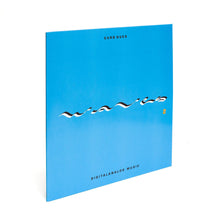Magazine / Germany / 2021 / LP+CD BOX
Curd Duca follows up last year's "Waves 1", his first album in two decades, with another flawless examination of sound and texture, contorting church bells, percussion, musical samples and field recordings methodically - and often humorously.
After his impressive 1990s/00s run on Normal and Mille Plateaux, he disappeared for 20 years before emerging from the aether last year. "Waves 2" takes off into more experimental realms, expanding on Duca's unusual combination of avantgarde aesthetics and organic qualities.
We get to hear 32 hypnotizing sonic experiments that range from burbling synth interferences and sequenced FM trickery to microtonal flute music and processed traffic sounds.
"Waves 2" is a hallucinatory experience, like a collage of mixtape assembled by one of the masters of the form, splicing together psychedelic synthesized wind sounds into cavernous glass percussion and granulated noise. - boomkat
. . . . . . .
Follow the Sounding of the Bells - Curd Duca´s Waves-Trilogy - by Jörg Heiser (author, art theorist, music critic (frieze, Spex, taz, artagenda ...)
A calm and steady gong opens Waves 1, heavy church bells prelude Waves, a mix of gong and bell Waves 3. Thus Curd Duca impressively marks his return after two decades - and also the entry into a triadic complex of temple, church and cathedral, vaulted by finely calibrated lucid dreams, pervaded by elusive temperaments and evocative sounds. The elegant Maestro of Electronic Moods is back, it was time.
Waves 1, 2 and 3 continue the flow of Duca´s music from the 1990ies and, at the same time, manage to radically transform it (perhaps a mark of genuine art: it keeps transforming in a way that makes continuity appear as a break and vive versa). The objective had been to constitute a genre sui generis that puts the conventions of entertainment (endearing, seductive, melodious...) against the conventions of the Avantgarde (negating, abrasive, difficult, annoying...), in a kind of negative dialectics, without falling into the trap of Neo-Esotericism.
The music is light and minimalist, phantasmatically openig up to various rooms, organically pulsating rather than marching to a beat. Or, to quote Duca himself, from an email-exchange in 1999: „goal: experimental, but not annoying... trying to make serious art with the following qualities: soothing, relaxing, light, transparent, gentle, peaceful, warm, soft, low-key, calm...“. Already back then, Duca turned away from late 80ies and early 90ies "groove terror“ (Duca 1999), the absolute fixation on beats.
Instead, he makes music that is committed to the phenomenology of sounds, organizing historical and contemporary sources towards a speculative future; music that evokes psychedelic qualities, not only as a sign for drug-fueled exaltation, but defined as modes of intensified perception - of sounds in their shape and form, their texture, tension and movement, and corresponding space-time dimensions.
All the albums of the trilogy follow the principle of alternating baths of colors and affects, in a daydream-like logic, unfolding in cineastic modulations and continually shifting perspectives, all of which allows, in a paradoxical twist, for a sense of continuity and tranquility. This music could be continuing itself endlessly, in a sense of constant transformation within a set of parameters (comparable to the idea of generative music with Eno) - by virtue of two factors: first, the potentially infinite availability (especially on the internet) of historical and present-day audio sources, respectively recordings; and secondly, Duca’s playful use of contemporary sound processing technologies. The manner in which Duca has been consistently utilizing these options points out a fundamental difference to constructivist approaches. Even though, as a trained architect, he can often be strict and formally precise, he nevertheless extends his antennas quite far, allowing for the (counter)-intuitive, organic and analog within the digital domain.
The kind of compression and expansion of time that he frequently employs in his music seems to have affected his production cycles. But through all incarnations, his aesthetics are rooted in minimalism and almost monk-like renunciation and, at the same time, a totally juicy approachability, and a desire for ecstasy and trance - not to be lulled but to explore with artistic focus and consequence, enabling a special kind of conscious dreaming. For some decades now, Duca has been developing his own style, his own genre, and has been building a spacious structure, a temple. Follow the sounding of the bells - and enter.






